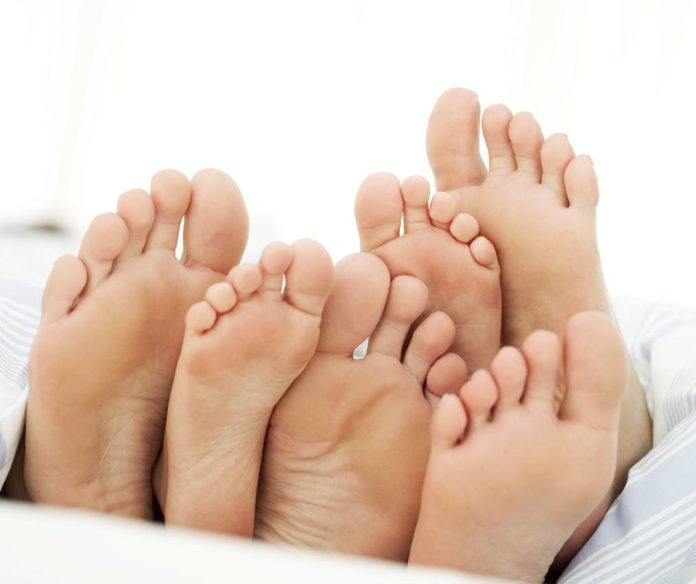With more than 26 bones, 33 joints, and more than one hundred muscles, tendons, and ligaments, the human foot is quite a complicated piece of anatomy. Many people take their feet for granted – until they start to hurt. Unfortunately, most people will have to deal with painful feet at some time.
The American Podiatric Medical Association (APMA) says that 75 percent of Americans will have some foot problem during their lifetime. Congenital issues or disabilities cause some problems, but most come from general wear and tear and abuse.
Here are some common foot problems and what you can do to treat them:
Plantar Fasciitis
This is an inflammation of the plantar fascia, the band of thick, connective tissue that runs from the heel bone to the toes, creating the arch of your foot. When the plantar fascia is overstretched or overused, it gets inflamed, causing pain and stiffness in the bottom of the heel and sometimes aching or a burning sensation in the bottom of the foot. Plantar fasciitis is one of the most common orthopedic foot complaints seen in both men and women. According to the National Institutes of Health, you’re more likely to get plantar fasciitis if you have foot arch problems, a sudden weight gain, shoes with poor arch support, or if you are involved in long-distance running.
Treatments – See your healthcare provider. They may start by recommending:
- Medication and/or ice treatments to reduce inflammation
- Stretching exercises for the heel and foot
- Rest
- Night splints
- Shoes with good support; shoe inserts or a heel cup
Treatment can last anywhere from several weeks to two years, though most feel better in about nine months. Sometimes, more drastic measures are called for, such as wearing a boot cast for several weeks, steroid shots, or foot surgery.
Bunions
A bunion occurs when the joint at the base of the big toe gets enlarged due to the big toe joint being moved out of place. The toe is forced to bend toward the other toes, which causes a painful lump of bone to form on the foot. The joint can also become stiff and sore, making it even more difficult to wear shoes or walk. According to the APMA, bunions are a symptom of faulty foot development and are usually caused by an inherited foot type, the way people walk, and the type of shoes worn.
Symptoms include redness, swelling, or pain near the big toe joint, a firm bump on the outside edge of the foot at the base of the big toe, and restricted or painful motion of the big toe.
Treatments – You can relieve some of the pain by:
- Using a commercial, non-medicated bunion pad
- Wearing shoes with a wide, deep toe box
- Avoiding high-heeled shoes
- Applying ice several times a day to reduce swelling.
You should visit a podiatrist if the pain persists. If left untreated, bunions can get larger and more painful. Your doctor may recommend padding and taping, anti-inflammatory drugs or cortisone injections, physical therapy or shoe inserts. Surgery to remove the bony enlargement and/or restore normal alignment may be necessary.
Ingrown Toenails
Ingrown nails are the most common nail problem. When one or both of the corners or sides of the nail curves and grows into the flesh, it can lead to irritation, redness, and swelling. Ingrown toenails can be caused by heredity, improperly trimmed nails, shoe pressure and crowding of toes, or repeated trauma to the feet from everyday activities such as running or walking.
Treatments – To relieve pain, immerse your foot in a basin of warm salt water or soapy water, then apply an antiseptic and bandage the affected area. However, anyone with diabetes, peripheral vascular disease, or other circulatory disorders should avoid any type of self-treatment, according to the APMA. Seek medical care as soon as possible. If there is drainage, odor, or excessive redness, you may have an infection. See a podiatrist or health care provider. For chronic problems with ingrown toenails, a podiatrist can remove a portion of the nail with a chemical, laser, or other outpatient procedure.
To prevent ingrown toenails:
- Avoid tight shoes and shoes with narrow or pointed toe boxes.
- Do not rip or tear the edges of your nails.
- Trim toenails by cutting them straight across.
- Do not dig into the corners, and only gently round off corners with a nail file.
Hammertoes
A hammertoe is a toe that is curled because there’s a bend in the toe’s middle joint. It can happen with any toe but is most often the second toe. It’s caused by an imbalance in the soft tissue, usually due to shoes that are too tight or shoes with high heels. These types of shoes force the toe against the front of the shoe, bending the toe unnaturally.
Symptoms of hammertoe can include redness and inflammation, joint stiffness, corns, calluses and open sores, and pain. If left untreated, symptoms can worsen, making it difficult to walk and wear shoes.
Treatments – Treatment options for hammertoes range from the simple to the surgical. Nonsurgical treatment options include:
- Wearing wider shoes with lower heels
- Doing toe exercises
- Using padding, tape, or splinting
- Taking medication for the pain
- Using orthotics











